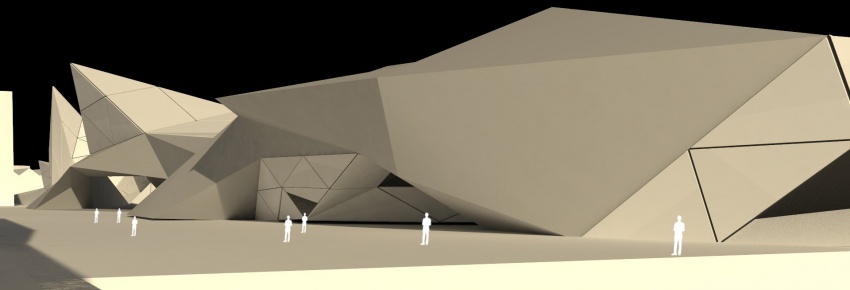Difference between revisions of "project04:Frontpage"
(→Eldin Fajkovic) |
|||
| Line 1: | Line 1: | ||
__NOTOC__ __NOTITLE__ | __NOTOC__ __NOTITLE__ | ||
[[File:Banner_AC.jpg|850px]] | [[File:Banner_AC.jpg|850px]] | ||
| + | Adaptive Composite is a pavilion which attempts to tackle three major problems, in regard of hosting the World Expo in Rotterdam in 2025. Firstly, the magnitude of incoming people stream. Secondly, the possibility of abandoned structures after the event has ended. Lastly, the focus of the pavilion on the citizen of Rotterdam, who exist for nearly 50% of migrants from over 174 different nationalities. | ||
| + | The functionality of the pavilion is focused on participatory entertainment and experience, meaning the border of producer and consumer is being blurred, giving the pavilion an open-source identity, where every individual can make a difference. This concept is physicalized through adaptation of responsiveness in the architecture, interconnected on component, function and pavilion scale. Changes made by individuals to components are reflected by the spatial ambiance, while the flow of people is tracked, so a response can be made by the spatial function in regard of spatial connectivity and people flow regulation. On the highest scale, the pavilion itself regulates the climate and energy in regard to the environment. | ||
| + | Structurally, the pavilion exists of two parts, the ‘body without organs’ and the ‘organs without body’, which when combined, composite ‘the organism’, a fully functioning and responding pavilion. The body exists of statically constructed pathways, computationally designed with the use of a stigmergic swarm algorithm. The organs, which manifest the various functions of the pavilion, can be plugged out of their position after the event has ended, which then can circulate or be placed in various spots in Rotterdam, corresponding to their function and adaptable possibilities. After the World Expo has ended, the body stays behind and becomes the host for possibly new organs, keeping the high dynamic of changing demand of functions at a constant possibility. | ||
| + | |||
==Eldin Fajkovic== | ==Eldin Fajkovic== | ||
Revision as of 21:32, 19 January 2016
 Adaptive Composite is a pavilion which attempts to tackle three major problems, in regard of hosting the World Expo in Rotterdam in 2025. Firstly, the magnitude of incoming people stream. Secondly, the possibility of abandoned structures after the event has ended. Lastly, the focus of the pavilion on the citizen of Rotterdam, who exist for nearly 50% of migrants from over 174 different nationalities.
The functionality of the pavilion is focused on participatory entertainment and experience, meaning the border of producer and consumer is being blurred, giving the pavilion an open-source identity, where every individual can make a difference. This concept is physicalized through adaptation of responsiveness in the architecture, interconnected on component, function and pavilion scale. Changes made by individuals to components are reflected by the spatial ambiance, while the flow of people is tracked, so a response can be made by the spatial function in regard of spatial connectivity and people flow regulation. On the highest scale, the pavilion itself regulates the climate and energy in regard to the environment.
Structurally, the pavilion exists of two parts, the ‘body without organs’ and the ‘organs without body’, which when combined, composite ‘the organism’, a fully functioning and responding pavilion. The body exists of statically constructed pathways, computationally designed with the use of a stigmergic swarm algorithm. The organs, which manifest the various functions of the pavilion, can be plugged out of their position after the event has ended, which then can circulate or be placed in various spots in Rotterdam, corresponding to their function and adaptable possibilities. After the World Expo has ended, the body stays behind and becomes the host for possibly new organs, keeping the high dynamic of changing demand of functions at a constant possibility.
Adaptive Composite is a pavilion which attempts to tackle three major problems, in regard of hosting the World Expo in Rotterdam in 2025. Firstly, the magnitude of incoming people stream. Secondly, the possibility of abandoned structures after the event has ended. Lastly, the focus of the pavilion on the citizen of Rotterdam, who exist for nearly 50% of migrants from over 174 different nationalities.
The functionality of the pavilion is focused on participatory entertainment and experience, meaning the border of producer and consumer is being blurred, giving the pavilion an open-source identity, where every individual can make a difference. This concept is physicalized through adaptation of responsiveness in the architecture, interconnected on component, function and pavilion scale. Changes made by individuals to components are reflected by the spatial ambiance, while the flow of people is tracked, so a response can be made by the spatial function in regard of spatial connectivity and people flow regulation. On the highest scale, the pavilion itself regulates the climate and energy in regard to the environment.
Structurally, the pavilion exists of two parts, the ‘body without organs’ and the ‘organs without body’, which when combined, composite ‘the organism’, a fully functioning and responding pavilion. The body exists of statically constructed pathways, computationally designed with the use of a stigmergic swarm algorithm. The organs, which manifest the various functions of the pavilion, can be plugged out of their position after the event has ended, which then can circulate or be placed in various spots in Rotterdam, corresponding to their function and adaptable possibilities. After the World Expo has ended, the body stays behind and becomes the host for possibly new organs, keeping the high dynamic of changing demand of functions at a constant possibility.